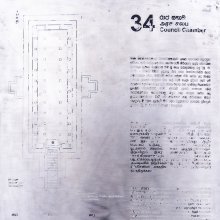Vaisha, Vaisa, Vaiśa, Vaiṣa: 4 definitions
Introduction:
Vaisha means something in Hinduism, Sanskrit, the history of ancient India, Hindi. If you want to know the exact meaning, history, etymology or English translation of this term then check out the descriptions on this page. Add your comment or reference to a book if you want to contribute to this summary article.
The Sanskrit terms Vaiśa and Vaiṣa can be transliterated into English as Vaisa or Vaisha, using the IAST transliteration scheme (?).
Images (photo gallery)
In Hinduism
Purana and Itihasa (epic history)
Source: Cologne Digital Sanskrit Dictionaries: The Purana IndexVaiśa (वैश).—Also Vidarbha; the son of Saivyā and Jyāmagha after the former's severe austerities; married Snuṣā; got two sons and a third Lomapāda.*
- * Vāyu-purāṇa 95. 36.

The Purana (पुराण, purāṇas) refers to Sanskrit literature preserving ancient India’s vast cultural history, including historical legends, religious ceremonies, various arts and sciences. The eighteen mahapuranas total over 400,000 shlokas (metrical couplets) and date to at least several centuries BCE.
India history and geography
Source: Wisdom Library: India HistoryVaisa refers to one of the 84 castes (gaccha) in the Jain community according to local Deccan tradition. The Jain caste and sub-caste system was a comparatively later development within their community, and it may have arisen from the ancient classification of Brāhmaṇa, Kṣatriya, Vaiśya and Śūdra. Before distinction of these classes (such as Vaisa), the society was not divided into distinct separate sections, but all were considered as different ways of life and utmost importance was attached to individual chartacter and mode of behaviour.
According to Dr. Vilas Adinath Sangava, “Jainism does not recognise castes (viz., Vaisa) as such and at the same time the Jaina books do not specifically obstruct the observance of caste rules by the members of the Jaina community. The attitude of Jainism towards caste is that it is one of the social practices, unconnected with religion, observed by people; and it was none of its business to regulate the working of the caste system” (source).
The legendary account of the origin of these 84 Jain castes (e.g., Vaisa) relate that once a rich Jain invited members of the Jain community in order to establish a vaiśya-mahāsabhā (i.e. Central Association of Traders). In response, 84 representatives came from different places, and they were later seen as the progenitors of these castes. Various sources however mention differences in the list.

The history of India traces the identification of countries, villages, towns and other regions of India, as well as mythology, zoology, royal dynasties, rulers, tribes, local festivities and traditions and regional languages. Ancient India enjoyed religious freedom and encourages the path of Dharma, a concept common to Buddhism, Hinduism, and Jainism.
Languages of India and abroad
Sanskrit dictionary
Source: DDSA: The practical Sanskrit-English dictionaryVaiṣa (वैष).—Slaughter; स वैषः स च संत्रासावेशः साप्यसहायता (sa vaiṣaḥ sa ca saṃtrāsāveśaḥ sāpyasahāyatā) Śiva B.23.25.
Derivable forms: vaiṣaḥ (वैषः).
Sanskrit, also spelled संस्कृतम् (saṃskṛtam), is an ancient language of India commonly seen as the grandmother of the Indo-European language family (even English!). Closely allied with Prakrit and Pali, Sanskrit is more exhaustive in both grammar and terms and has the most extensive collection of literature in the world, greatly surpassing its sister-languages Greek and Latin.
Hindi dictionary
Source: DDSA: A practical Hindi-English dictionaryVaisā (वैसा):—(a) of that kind/nature, like that, such as that; —[hī] exactly like that, of that very type/manner.
...
See also (Relevant definitions)
Starts with (+17): Vaishadya, Vaishaka, Vaishakapurnima, Vaishakh, Vaishakha, Vaishakhamahatmya, Vaishakhamasavrata, Vaishakhapurana, Vaishakharajju, Vaishakharecita, Vaishakhashukladvadashi, Vaishakhashuklaikadashi, Vaishakhasnana, Vaishakhasnanavidhi, Vaishakhasthana, Vaishakhasthanaka, Vaishakhavadi, Vaishakhavrata, Vaishakhavritti, Vaishakhi.
Query error!
Full-text: Jaisa, Mukharay, Esa, Cantiramatam, Aisa, Yajus, Jyamagha, Vidarbha.
Relevant text
Search found 20 books and stories containing Vaisha, Vaisa, Vaiśa, Vaiṣa, Vaisā; (plurals include: Vaishas, Vaisas, Vaiśas, Vaiṣas, Vaisās). You can also click to the full overview containing English textual excerpts. Below are direct links for the most relevant articles:
Historical Elements in the Matsya Purana (by Chaitali Kadia)
Varṇa (3): The Vaiśyas < [Chapter 5 - Cultural history in the Matsya-Purāṇa]
Varṇa (classification) (Introduction) < [Chapter 5 - Cultural history in the Matsya-Purāṇa]
Politics in the Matsya Purāṇa (Introduction) < [Chapter 5 - Cultural history in the Matsya-Purāṇa]
Vedavyasa < [Third Section]
Notices of Sanskrit Manuscripts (by Rajendralala Mitra)
Brihad Bhagavatamrita (commentary) (by Śrī Śrīmad Bhaktivedānta Nārāyana Gosvāmī Mahārāja)
Verse 1.3.33 < [Chapter 3 - Prapañcātīta (beyond the Material Plane)]
Verse 1.4.9 < [Chapter 4 - Bhakta (the devotee)]
Chaitanya Bhagavata (by Bhumipati Dāsa)
Verse 3.10.162 < [Chapter 10 - The Glories of Śrī Puṇḍarīka Vidyānidhi]
Markandeya Purana (Study) (by Chandamita Bhattacharya)
Division of Varṇa (c): The Vaiśyas < [Chapter 2]
